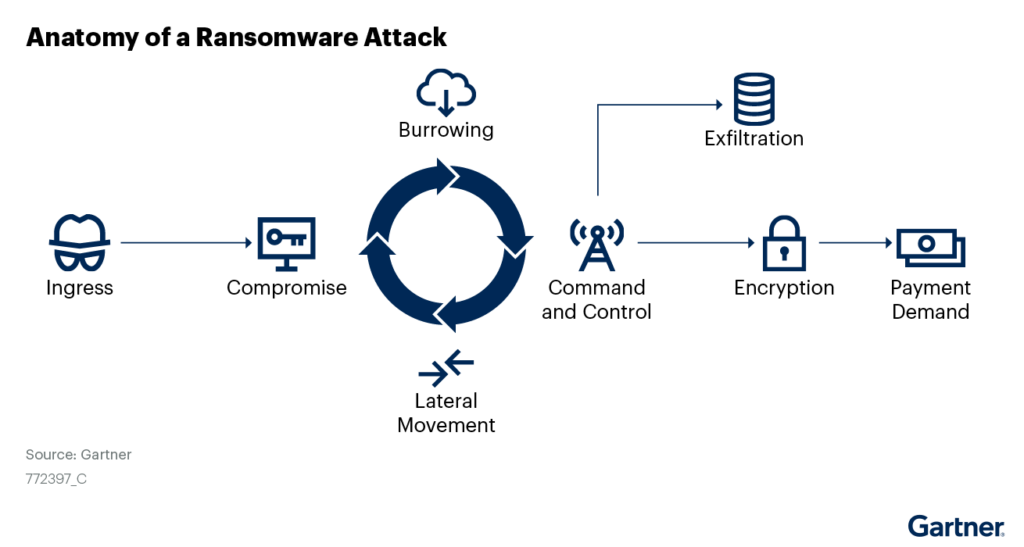It’s often said in cybersecurity that it’s not a question of if an attack takes place but rather when. Ransomware tactics are evolving, deploying increasingly sophisticated and human approaches. And, they’re profitable. On average, 47% of enterprises pay the ransom, making ransomware a lucrative criminal industry. Yet, the actual cost of a ransomware attack does not come from the ransom itself, but from the sudden, disruptive business impact the attack creates.
Ransomware is a malicious software originally designed to identify vulnerabilities in a network. Created to do no harm, ransomware evolved into a tool for fraudsters seeking easy sources of revenue. Ransomware helps cyber criminals generate income by blackmailing the victim and demanding them to pay for data recovery.

Ransomware has transformed from its beginnings of automatic attacks into human-operated, targeted campaigns with sophisticated strategies. Gartner forecasts that 75% of IT organizations experience an attack by 2025. With 2023 already here and the threat looming closer, organizations face the challenge of developing and implementing plans to protect against ransomware and recover from attacks.
Ransomware Attacks Hurt (Real Bad)
According to Gartner, the primary target for ransomware attacks is the midsize enterprise, 90% of which make less than $1 billion annually and 82% of which employ less than 1000 people. While midsize businesses are disproportionately vulnerable to ransomware attacks, any business is a potential target and may experiences the aftershock of an attack such as:
- Full data loss. There is no guarantee that satisfying the demand of a fraudster will completely restore your data. Statistics show that around 35% of data has zero possibility of recovery. The slippery slope of a data breach can lead to expensive legal actions such as fines or lawsuits and regulatory penalties to the business.
- Leadership turnover. The key task of every security leader is to ensure business continuity and prevent the ‘when it happens’ event from happening. In 68% of organizations the leader is the one to take a blame for a ransomware attack.
- Business disruption. Ransomware attacks may lead to a minimum 20 days of business disruption. This may result in failing to deliver necessary services to customers on time, planting the seed of doubt in the company’s reliability.
So How Do I Protect My Business From Ransomware?
A comprehensive ransomware recovery strategy enables organizations to effectively respond and recover from attacks, reducing the costs of an attack and restoring business processes faster. This recovery strategy should encompass preventive measures such as regular system updates, robust cybersecurity protocols, and up-to-date endpoint management solutions from a trusted provider. Resources and employee awareness training should be widely available to mitigate the risk of an attack. Moreover, regular data backups, encryption solutions, and sensitive data protection protocols are essential to ensure data availability and integrity during recovery.

A successful ransomware recovery strategy should include incident response plans outlining roles, responsibilities, and communication channels. This facilitates an attack’s swift detection and containment, limiting its impact. Organizations should also establish partnerships with cybersecurity experts, like those at Data443, who specialize in anti-ransomware software, including malware prevention and recovery strategies.
By prioritizing a ransomware recovery strategy, enterprises demonstrate their commitment to protecting their operations, customers, and stakeholders. A comprehensive ransomware playbook helps minimize operational downtime and financial disruption, safeguards critical business data, preserves brand reputation, and ensures regulatory compliance.
In order to make sure the business is secured from any IT disaster, the management has to think of the worst case scenario and develop a strategy that allows it to detect a threat at the earliest stage. A ransomware attack could cripple operations and lead to significant financial losses. To avoid the nightmare, management must proactively develop a robust recovery plan. This plan acts as a safety net, enabling early threat detection, minimizing the impact of attacks, and swiftly restoring crucial business processes. By failing to prepare, the business is preparing to fail. Safeguarding your business from ransomware threats requires foresight, proactive measures, and a well-executed recovery strategy.
Conclusion
Data443’s Ransomware Recovery Manager was recently named ‘Best for Inexpensive Protection’ and ‘Best for Kiosks’ by PCMag, a leading authority on technology. So, if you want to keep your device and data safe from those pesky ransomware attacks, Data443’s Ransomware Recovery Manager is the way to go! And if your company needs help with ransomware recovery, you should totally reach out to the Data443 experts.
Stay tuned for our next article that will explore the ways to help leadership reduce the risks of a negative ransomware impact.
